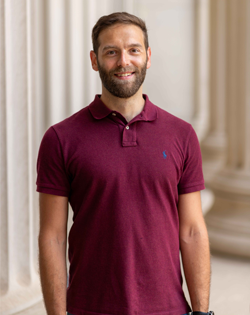3D genome dynamics in differentiation and pathology
Michele Gabriele

Email: gabriele.michele@hsr.it
Location:
SR-Tiget Group Leader, 3D genome dynamics in differentiation and disease
Understanding the mechanisms of chromatin regulation in development and pathology has always fascinated me. During my career I approached this topic from several perspectives. I studied at the University of Pisa with a thesis on the genetics of DNA damage repair and breast cancer. Then, I moved to Milan, where in 2019, I completed my PhD in Systems Medicine at the European School of Molecular Medicine (SEMM) under the mentorship of Giuseppe Testa at the European Institute of Oncology (IEO). There, I studied how mutations in chromatin regulators cause pathologies, in particular, neurodevelopmental disorders. With patient-derived iPSCs, we modeled neurodevelopmental conditions in disease-relevant tissues to identify the downstream molecular effects. We also discovered that mutations in the chromatin regulator YY1 cause a rare neurodevelopmental disorder later identified as Gabriele de-Vries syndrome. To develop new tools for studying the molecular mechanisms underlying gene expression regulation, for my postdoc, I joined the biophysics lab of Anders Sejr Hansen, at MIT, biological engineering. There, I established a new multidisciplinary approach that combined biophysical approaches with genome engineering to study chromatin dynamics in living cells. We discovered that chromatin is very dynamic and fully looped structures are rare. I was awarded the American Italian Cancer Foundation (AICF) postdoctoral fellowship and later with the prestigious NIH K99 “Pathway to Independence Award” to adapt my previous strategy to the study of enhancer-promoter interactions during differentiation. With this new experimental platform and expertise, I decided to return to Italy, where I will open my laboratory at the San Raffaele Telethon Institute for Gene Therapy in June 2025. The goal of my laboratory is to understand the mechanisms of 3D genome regulation during cell differentiation, to comprehend the consequences of its dysregulation, and to engineer these mechanisms to develop new therapies.
